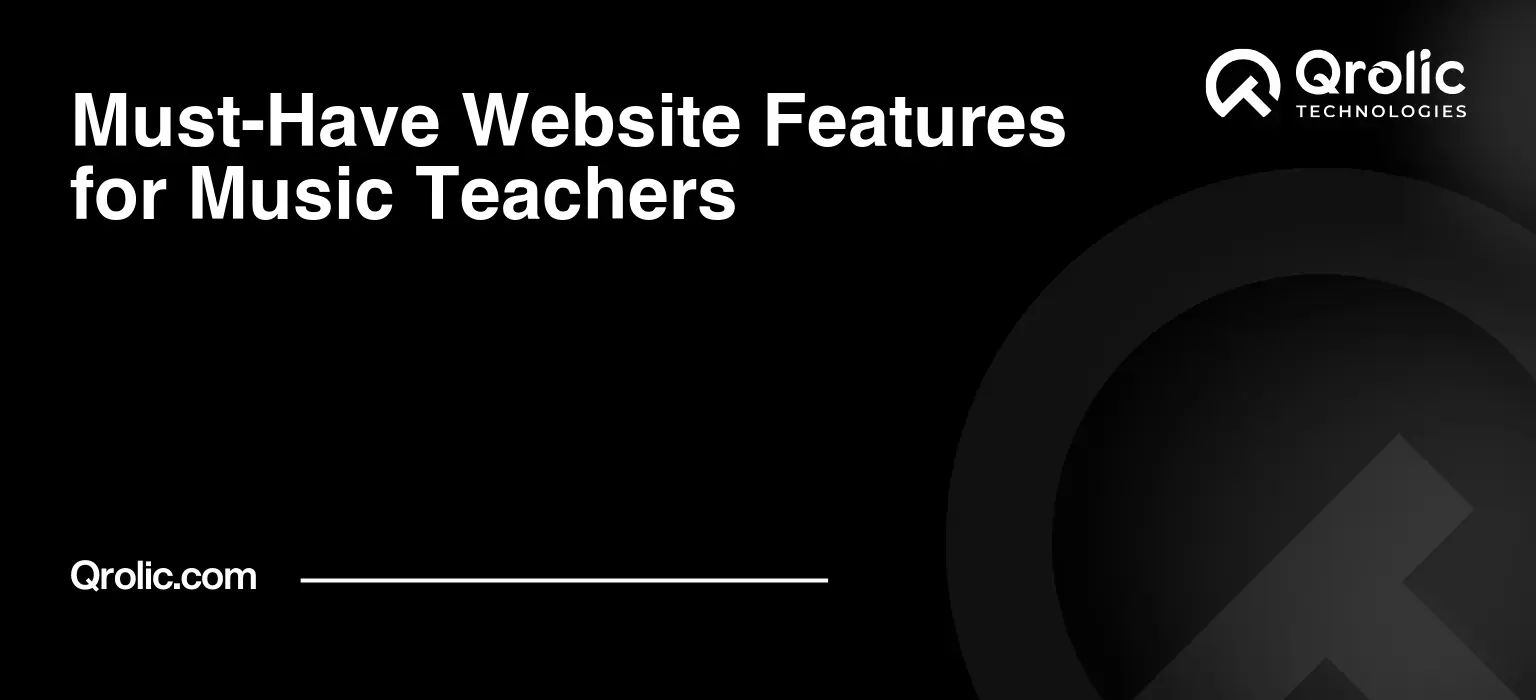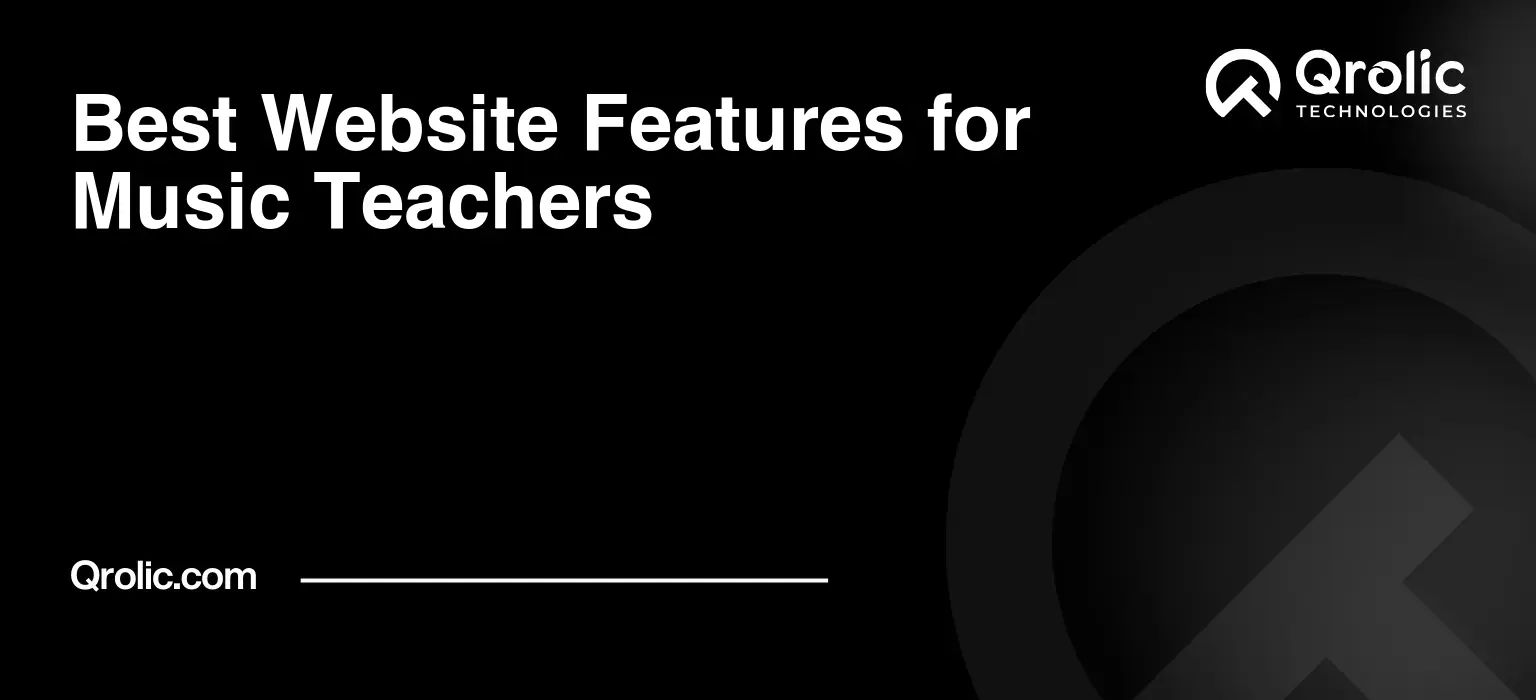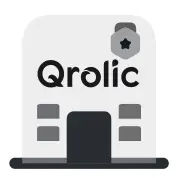Quick Summary:
- A website expands reach and builds credibility for music teachers.
- Include clear services, easy booking, and student testimonials.
- Optimize for search engines and be mobile-friendly.
- Choose the right platform and track your website’s success.
Table of Contents
- Why Music Teachers Need a Dedicated Website
- Expanding Your Reach Beyond Local Limits
- Establishing Professional Credibility and Authority
- Streamlining Communication and Administration
- Showcasing Your Unique Teaching Style and Expertise
- Core Functionality: The Foundation of Your Music Teaching Website
- About Me: Crafting Your Personal Narrative
- Services Offered: Clearly Defining Your Offerings
- Class Schedule: Simplifying the Booking Process
- Booking/Contact Form: Making it Easy to Connect
- Testimonials: Building Trust Through Social Proof
- Blog: Establishing Expertise and Attracting Organic Traffic
- Advanced Features: Elevating Your Website to the Next Level
- Online Payment Integration: Streamlining Transactions
- Student Portal: Enhancing the Learning Experience
- Email Marketing: Nurturing Leads and Engaging Students
- Search Engine Optimization (SEO): Driving Organic Traffic
- Mobile Responsiveness: Catering to On-the-Go Users
- Accessibility: Ensuring Inclusivity for All Users
- Design Considerations: Creating an Engaging and Professional Website
- Visual Appeal: Captivating Your Audience
- User Experience (UX): Ensuring Smooth Navigation
- Branding: Reflecting Your Unique Identity
- Choosing the Right Platform: Selecting the Best Fit for Your Needs
- WordPress: The Versatile Choice
- Wix/Squarespace: The User-Friendly Options
- Specialized Platforms: Tailored Solutions for Music Teachers
- Leveraging Qrolic Technologies for Your Music Teaching Website
- Website Development and Design
- SEO Optimization
- Content Creation
- Digital Marketing
- Website Maintenance and Support
- Measuring Success: Tracking Your Website’s Performance
- Key Metrics to Track
- Tools for Tracking Performance
- Final Thoughts: Building a Thriving Online Presence
Why Music Teachers Need a Dedicated Website
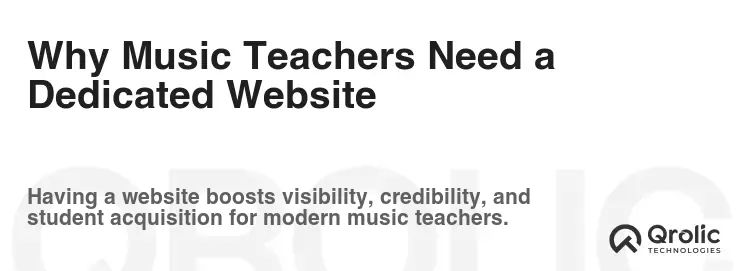
The digital age has irrevocably altered the landscape of education, and music teaching is no exception. A dedicated website is no longer a luxury but a necessity for music teachers seeking to thrive. Imagine your website as your 24/7 virtual assistant, constantly working to promote your services, connect with potential students, and streamline your administrative tasks. It’s about expanding your reach, saving time, and ultimately, focusing more on what you love – teaching music.
Expanding Your Reach Beyond Local Limits
A website transcends geographical limitations. You’re no longer confined to attracting students solely within your immediate neighborhood. A well-optimized website can attract students from across the city, state, or even globally if you offer online lessons. This opens up a far larger pool of potential students, increasing your earning potential and building a more diverse student base.
Establishing Professional Credibility and Authority
In a competitive market, credibility is paramount. A professional-looking website instantly elevates your perceived expertise and trustworthiness. It’s your digital business card, showcasing your qualifications, experience, and teaching philosophy. It allows potential students to thoroughly research you before making a commitment, fostering trust and confidence in your abilities. Think of it as building your own digital music academy, even if you’re a solo teacher.
Streamlining Communication and Administration
A website equipped with features like online scheduling, automated email responses, and integrated payment systems can significantly reduce the administrative burden of running a music teaching business. No more endless phone calls, missed appointments, or chasing after payments. You can automate these tasks, freeing up valuable time to focus on lesson planning and student engagement.
Showcasing Your Unique Teaching Style and Expertise
A website provides the perfect platform to showcase your unique teaching style, specialties, and accomplishments. Share student testimonials, performance videos, and blog posts on music education topics to demonstrate your passion and expertise. This allows potential students to get a real feel for your teaching approach and determine if you’re the right fit for their learning style.
Core Functionality: The Foundation of Your Music Teaching Website
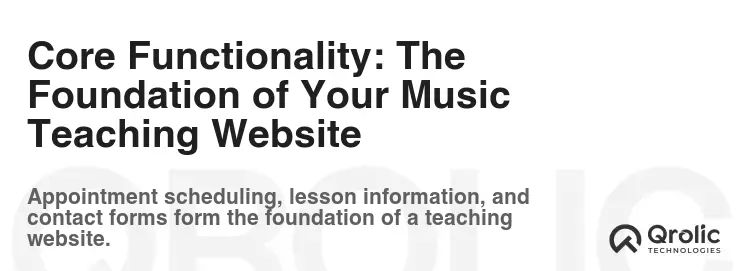
A robust foundation is crucial for a successful music teaching website. These core features ensure a seamless and informative experience for visitors, converting them into engaged students.
About Me: Crafting Your Personal Narrative
This is often the first page a prospective student will visit. It’s your opportunity to make a strong first impression and showcase your personality and expertise.
- Detailed Biography: Include your educational background, teaching experience, performance history, and any relevant certifications or awards. Don’t just list your accomplishments; weave them into a compelling narrative that demonstrates your passion for music and teaching.
- Teaching Philosophy: Clearly articulate your teaching philosophy and methodology. What is your approach to music education? What are your goals for your students? What makes your teaching unique?
- Personal Touch: Inject your personality into the page. Share anecdotes, personal interests, and a genuine enthusiasm for music. This will help potential students connect with you on a more personal level.
- High-Quality Photo: Include a professional headshot that conveys your personality and professionalism.
- Call to Action: Encourage visitors to take the next step, such as scheduling a consultation or contacting you for more information.
Services Offered: Clearly Defining Your Offerings
Clearly outline the services you offer, providing detailed information about each to attract the right students.
- Lesson Types: Specify the types of lessons you offer (e.g., private lessons, group classes, online lessons, workshops).
- Instruments Taught: List all the instruments you teach, including voice.
- Skill Levels: Define the skill levels you cater to (e.g., beginner, intermediate, advanced).
- Age Groups: Indicate the age groups you teach (e.g., children, teenagers, adults).
- Detailed Descriptions: Provide detailed descriptions of each service, highlighting the benefits and learning outcomes for students.
- Pricing Information: Be transparent about your pricing structure. Clearly state your lesson rates, package deals, and any associated fees. If you’re not comfortable listing exact prices, provide a range or offer a free consultation to discuss pricing.
- Curriculum Outline (Optional): For specific courses or programs, provide a brief curriculum outline to give students a sense of the learning journey.
Class Schedule: Simplifying the Booking Process
An easily accessible and intuitive class schedule is crucial for maximizing student enrollment and minimizing scheduling conflicts.
- Interactive Calendar: Implement an interactive calendar that allows students to view available time slots and book lessons directly.
- Real-Time Availability: Ensure the calendar displays real-time availability, preventing double bookings and scheduling errors.
- Filtering Options: Allow students to filter by instrument, level, or teacher (if you have multiple teachers).
- Time Zone Awareness: If you offer online lessons, ensure the calendar displays time slots in the student’s local time zone.
- Integration with Booking System: Integrate the calendar with a booking system to automate appointment confirmations, reminders, and cancellations.
Booking/Contact Form: Making it Easy to Connect
Make it incredibly easy for potential students to reach out and inquire about lessons or book a consultation.
- Clear Call to Action: Prominently display a “Book a Lesson” or “Contact Us” button on every page.
- Simple and Concise Form: Keep the form short and only ask for essential information (e.g., name, email, phone number, instrument of interest).
- Dropdown Menus: Use dropdown menus for selecting instruments, skill levels, or preferred lesson times.
- Captcha Verification: Implement captcha verification to prevent spam submissions.
- Confirmation Message: Display a clear confirmation message after the form is submitted, assuring the user that their inquiry has been received.
- Automated Response: Set up an automated email response to acknowledge receipt of the inquiry and provide an estimated response time.
Testimonials: Building Trust Through Social Proof
Positive testimonials from satisfied students are powerful social proof that can significantly influence potential students.
- Authentic Quotes: Feature authentic quotes from real students that highlight the benefits of your teaching.
- Student Photos (Optional): Include photos of your students (with their permission) to add a personal touch and increase credibility.
- Video Testimonials (Highly Recommended): Video testimonials are even more impactful than written quotes. Encourage students to record short video clips sharing their experiences.
- Variety of Perspectives: Showcase a variety of perspectives from students of different ages, skill levels, and instruments.
- Regularly Update: Regularly update your testimonials to keep the content fresh and relevant.
- Link to Profiles (Optional): If possible, link testimonials to the student’s social media profiles (e.g., LinkedIn, Facebook) to further enhance credibility.
Blog: Establishing Expertise and Attracting Organic Traffic
A blog is an invaluable tool for establishing yourself as an authority in music education, attracting organic traffic to your website, and engaging with your audience.
- Relevant and Engaging Content: Create blog posts on topics that are relevant to your target audience (e.g., tips for practicing, choosing an instrument, music theory concepts, performance techniques).
- Keyword Optimization: Optimize your blog posts for relevant keywords to improve your search engine ranking.
- Consistent Posting Schedule: Establish a consistent posting schedule (e.g., weekly or bi-weekly) to keep your audience engaged and coming back for more.
- Multimedia Content: Incorporate multimedia content, such as images, videos, and audio examples, to make your blog posts more engaging and informative.
- Call to Action: Include a call to action at the end of each blog post, encouraging readers to book a lesson or contact you for more information.
- Shareable Content: Make your blog posts easy to share on social media platforms.
- Guest Blogging (Optional): Invite guest bloggers to contribute content to your blog to broaden your audience and diversify your content.
Advanced Features: Elevating Your Website to the Next Level

These advanced features will further enhance your website’s functionality, user experience, and marketing effectiveness.
Online Payment Integration: Streamlining Transactions
Integrating online payment processing streamlines transactions, making it convenient for students to pay for lessons and reducing administrative overhead.
- Secure Payment Gateway: Choose a secure payment gateway, such as PayPal, Stripe, or Square, to protect student financial information.
- Recurring Billing: Set up recurring billing for students who pay for lessons on a regular basis.
- Automated Invoicing: Generate automated invoices for each lesson or payment.
- Payment Reminders: Send automated payment reminders to students who have outstanding balances.
- Multiple Payment Options: Offer multiple payment options, such as credit cards, debit cards, and bank transfers.
- Discount Codes: Create discount codes for new students or special promotions.
Student Portal: Enhancing the Learning Experience
A dedicated student portal provides a secure and personalized space for students to access lesson materials, track their progress, and communicate with you.
- Lesson Materials: Upload lesson materials, such as sheet music, exercises, and practice recordings, for students to access.
- Progress Tracking: Track student progress, including attendance, assignments, and performance evaluations.
- Communication Tools: Provide communication tools, such as messaging or forums, for students to ask questions and interact with you and other students.
- Personalized Learning Plans: Create personalized learning plans for each student, outlining their goals and objectives.
- Practice Logs: Allow students to track their practice time and record their progress.
- Secure File Sharing: Enable secure file sharing for students to submit assignments and receive feedback.
Email Marketing: Nurturing Leads and Engaging Students
Email marketing is a powerful tool for nurturing leads, engaging with students, and promoting your services.
- Email List Building: Build an email list by offering a free resource, such as a practice guide or a sample lesson, in exchange for email addresses.
- Automated Email Sequences: Create automated email sequences to welcome new subscribers, nurture leads, and onboard new students.
- Regular Newsletter: Send a regular newsletter to your email list with updates on your services, upcoming events, and helpful music education tips.
- Segmentation: Segment your email list based on interests, skill levels, or instruments to send targeted messages.
- Personalization: Personalize your email messages with the recipient’s name and other relevant information.
- Track Email Performance: Track the performance of your email campaigns, including open rates, click-through rates, and conversions.
Search Engine Optimization (SEO): Driving Organic Traffic
SEO is crucial for ensuring that your website ranks well in search engine results, driving organic traffic and attracting potential students.
- Keyword Research: Conduct thorough keyword research to identify the keywords that potential students are using to search for music teachers in your area. (keywords: music teaching website, class schedule, booking)
- On-Page Optimization: Optimize your website’s content, including page titles, meta descriptions, and headings, with relevant keywords.
- Off-Page Optimization: Build high-quality backlinks from other websites to improve your website’s authority and search engine ranking.
- Local SEO: Optimize your website for local search to attract students in your local area.
- Mobile Optimization: Ensure that your website is mobile-friendly to provide a seamless user experience on all devices.
- Website Speed: Optimize your website’s speed to improve user experience and search engine ranking.
- Analytics Tracking: Track your website’s traffic and performance using Google Analytics to identify areas for improvement.
Mobile Responsiveness: Catering to On-the-Go Users
In today’s mobile-first world, a mobile-responsive website is essential for providing a seamless user experience on all devices.
- Fluid Layout: Use a fluid layout that adapts to different screen sizes.
- Touch-Friendly Navigation: Ensure that your website’s navigation is touch-friendly and easy to use on mobile devices.
- Optimized Images: Optimize images for mobile devices to reduce loading times.
- Mobile-Specific Content: Consider creating mobile-specific content, such as simplified forms or shorter text paragraphs.
- Testing on Multiple Devices: Test your website on a variety of mobile devices to ensure that it displays correctly.
Accessibility: Ensuring Inclusivity for All Users
Accessibility is crucial for ensuring that your website is usable by people with disabilities.
- Alternative Text for Images: Provide alternative text for all images to describe their content to visually impaired users.
- Keyboard Navigation: Ensure that your website can be navigated using a keyboard.
- Clear and Concise Language: Use clear and concise language that is easy to understand.
- Sufficient Color Contrast: Ensure that there is sufficient color contrast between text and background to improve readability.
- Proper Heading Structure: Use a proper heading structure to organize your content and make it easier for screen readers to navigate.
- WAI-ARIA Attributes: Use WAI-ARIA attributes to provide additional information about the structure and functionality of your website to assistive technologies.
Design Considerations: Creating an Engaging and Professional Website
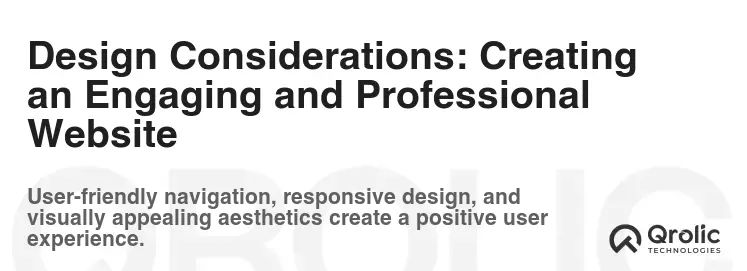
The design of your website plays a crucial role in attracting and retaining visitors. A well-designed website is visually appealing, easy to navigate, and reflects your brand identity.
Visual Appeal: Captivating Your Audience
- Professional Color Palette: Choose a professional color palette that reflects your brand identity and appeals to your target audience.
- High-Quality Images: Use high-quality images that are relevant to your content and enhance the visual appeal of your website.
- Clean and Modern Layout: Opt for a clean and modern layout that is easy to navigate and visually appealing.
- Whitespace: Use whitespace effectively to create a sense of balance and readability.
- Consistent Branding: Maintain consistent branding throughout your website, including your logo, color palette, and typography.
User Experience (UX): Ensuring Smooth Navigation
- Intuitive Navigation: Design an intuitive navigation system that allows visitors to easily find the information they are looking for.
- Clear Call to Actions: Use clear call to actions to guide visitors towards desired actions, such as booking a lesson or contacting you for more information.
- Fast Loading Speeds: Optimize your website’s speed to provide a smooth and seamless user experience.
- Mobile-Friendly Design: Ensure that your website is mobile-friendly to provide a consistent user experience on all devices.
- Easy-to-Read Typography: Choose easy-to-read typography that is appropriate for your target audience.
Branding: Reflecting Your Unique Identity
- Logo Design: Invest in a professional logo design that reflects your brand identity and values.
- Brand Voice: Develop a consistent brand voice that resonates with your target audience.
- Brand Story: Craft a compelling brand story that communicates your mission, vision, and values.
- Brand Guidelines: Create brand guidelines to ensure consistency in your branding across all platforms.
- Visual Elements: Use visual elements, such as colors, fonts, and imagery, to reinforce your brand identity.
Choosing the Right Platform: Selecting the Best Fit for Your Needs

Selecting the right platform for your music teaching website is crucial for ensuring its functionality, scalability, and ease of management.
WordPress: The Versatile Choice
WordPress is a popular content management system (CMS) that offers a high degree of flexibility and customization.
- Pros:
- Highly customizable with a vast library of themes and plugins.
- SEO-friendly.
- Large and active community support.
- Scalable for growing businesses.
- Cons:
- Requires some technical knowledge to set up and maintain.
- Can be vulnerable to security threats if not properly secured.
- Requires ongoing maintenance and updates.
- Best For: Teachers who want a highly customizable website and are comfortable with some technical aspects.
Wix/Squarespace: The User-Friendly Options
Wix and Squarespace are website builders that offer a drag-and-drop interface and user-friendly design tools.
- Pros:
- Easy to use with no coding required.
- Visually appealing templates.
- All-in-one platform with hosting and security included.
- Cons:
- Less customizable than WordPress.
- Limited SEO capabilities.
- Can be more expensive than WordPress in the long run.
- Best For: Teachers who want a simple and visually appealing website without the need for coding.
Specialized Platforms: Tailored Solutions for Music Teachers
Some platforms are specifically designed for music teachers, offering features such as online scheduling, student management, and billing.
- Examples: My Music Staff, Teachworks.
- Pros:
- Tailored features for music teaching businesses.
- Streamlined student management.
- Integrated billing and payment processing.
- Cons:
- Can be more expensive than general website builders.
- Less customizable than WordPress.
- May not offer the same level of design flexibility.
- Best For: Teachers who need specialized features for managing their music teaching business.
Leveraging Qrolic Technologies for Your Music Teaching Website
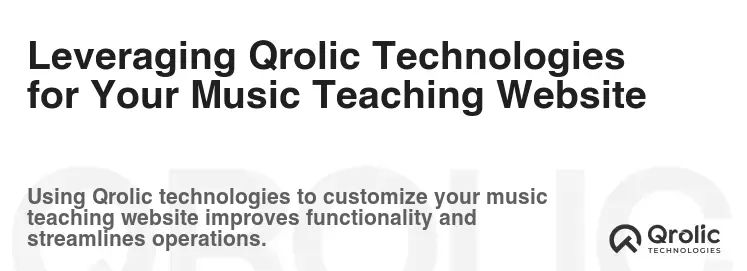
Qrolic Technologies (https://qrolic.com/) can be a valuable partner in developing and optimizing your music teaching website. They offer a range of services that can help you create a professional, engaging, and effective online presence.
Website Development and Design
Qrolic Technologies can help you design and develop a custom website that reflects your brand identity and meets your specific needs. They can create a visually appealing and user-friendly website that showcases your teaching services and attracts potential students. They can help you build a music teaching website. They can create a robust class schedule, and can help in booking .
SEO Optimization
Qrolic Technologies can help you optimize your website for search engines, ensuring that it ranks well in search results and attracts organic traffic. They can conduct keyword research, optimize your website’s content, and build high-quality backlinks to improve your search engine ranking.
Content Creation
Qrolic Technologies can help you create engaging and informative content for your website, including blog posts, articles, and videos. They can help you establish yourself as an authority in music education and attract a wider audience.
Digital Marketing
Qrolic Technologies can help you develop and implement a digital marketing strategy to promote your music teaching services online. They can manage your social media accounts, run targeted advertising campaigns, and track your marketing performance.
Website Maintenance and Support
Qrolic Technologies can provide ongoing website maintenance and support, ensuring that your website is always up-to-date, secure, and performing optimally. They can handle technical issues, update your content, and provide technical support to your students.
Measuring Success: Tracking Your Website’s Performance

Measuring your website’s performance is crucial for understanding its effectiveness and identifying areas for improvement.
Key Metrics to Track
- Traffic: Track the number of visitors to your website, including unique visitors, page views, and bounce rate.
- Engagement: Track how visitors are engaging with your website, including time on site, pages per visit, and social shares.
- Conversions: Track the number of visitors who are converting into leads or students, including form submissions, lesson bookings, and email sign-ups.
- SEO Ranking: Track your website’s ranking in search engine results for relevant keywords.
- Website Speed: Track your website’s loading speed to ensure a smooth user experience.
- Mobile Performance: Track your website’s performance on mobile devices.
Tools for Tracking Performance
- Google Analytics: A free web analytics service that provides detailed information about your website’s traffic, engagement, and conversions.
- Google Search Console: A free tool that provides insights into your website’s search performance, including keyword rankings, backlinks, and crawl errors.
- Website Speed Testing Tools: Use tools like Google PageSpeed Insights or GTmetrix to test your website’s loading speed.
- SEO Ranking Trackers: Use tools like SEMrush or Ahrefs to track your website’s ranking in search engine results.
By tracking these metrics and using the appropriate tools, you can gain valuable insights into your website’s performance and make data-driven decisions to improve its effectiveness.
Final Thoughts: Building a Thriving Online Presence
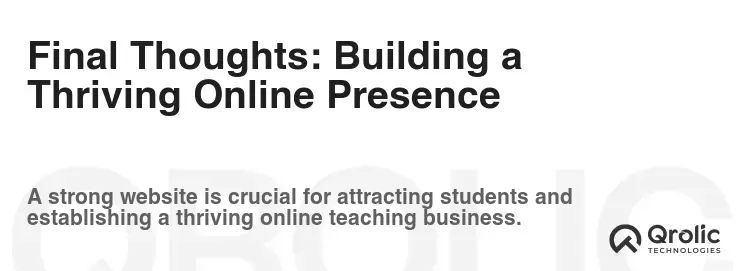
Building a successful music teaching website is an ongoing process. By implementing the features and strategies outlined in this article, you can create a website that attracts potential students, streamlines your administrative tasks, and helps you build a thriving online presence. Remember to continuously evaluate your website’s performance, adapt to changing trends, and always prioritize the user experience. With dedication and a strategic approach, your website can become a powerful tool for growing your music teaching business. Remember that the key features of music teaching websites include the availability of class schedule, and easy of booking.
